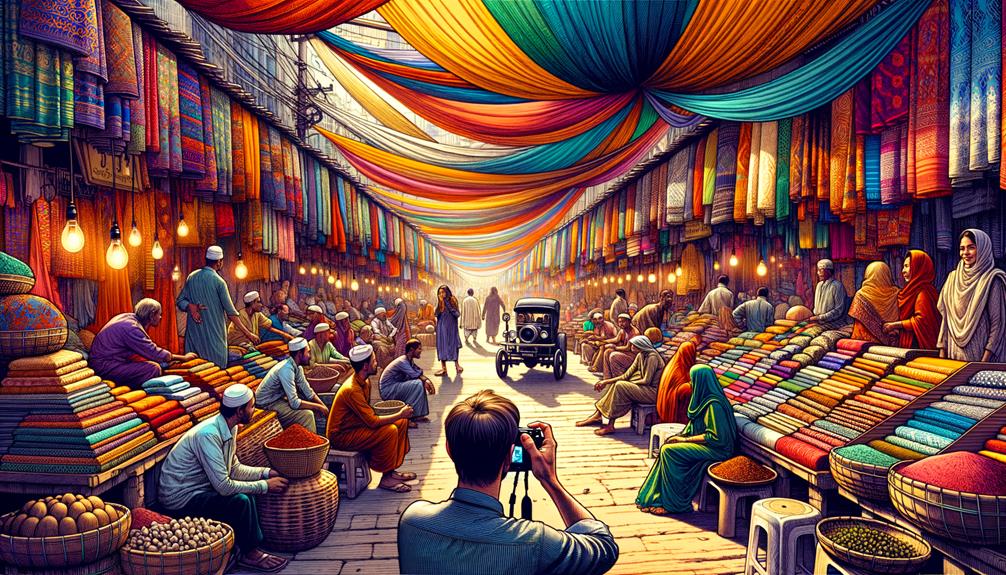Nestled in the mid-western region of Bangladesh, Rajshahi District, also known as the Silk City, offers a captivating blend of natural beauty, historical significance, and economic prowess. As we begin to unravel the layers of this district's rich tapestry, we embark on a journey that takes us through its lush alluvial plains, ten meandering rivers, and the intriguing story of its establishment as a separate district. However, the true allure of Rajshahi lies in its economic significance, particularly its thriving silk production and mango cultivation industries. So, join me as we delve into the multifaceted facets of this Silk City, where tales of sericulture and agricultural importance await.
Geography and Rivers
The geography of Rajshahi District in mid-western Bangladesh is characterized by a fertile alluvial plain and a network of rivers that contribute to its agricultural productivity and economic prosperity. The district boasts a well-developed irrigation system, ensuring a consistent supply of water for cultivation. This system allows farmers to grow a variety of crops, including rice, wheat, jute, and vegetables. The rivers in Rajshahi District not only serve as a source of irrigation but also play a crucial role in the transportation network. They provide a means of transportation for goods and people, facilitating trade and commerce within and beyond the district. The rivers connect Rajshahi District to other parts of Bangladesh, enhancing its economic potential and making it a vital hub for agricultural activities and trade.
History
With a rich and storied past, Rajshahi District unveils a captivating history that spans centuries, showcasing its significance in the cultural and political landscape of Bangladesh. Here are three key highlights:
- Mughal Connection: Rajshahi's history dates back to the Mughal era, when it was given to the Puṭhia Raj family by Emperor Akbar. This royal connection adds an air of grandeur to the district, with remnants of Mughal architecture still visible in the form of ancient palaces and temples.
- Liberation War: Rajshahi District played a crucial role in the Bangladesh Liberation War of 1971. It witnessed significant battles and atrocities committed by the Pakistan Army, leaving a lasting impact on its people and the nation's history. The district stands as a symbol of resilience and bravery in the face of oppression.
- Historical Significance: From being established in 1772 to becoming a municipal town in 1876, Rajshahi has witnessed the formation of separate districts over time. Its historical journey reflects the evolution of governance and administration in Bangladesh, making it an important part of the country's heritage.
Rajshahi District's history is a tapestry of cultural, political, and social events that continue to shape its identity today.
Demographics
Rajshahi District reveals a diverse population and a vibrant social fabric that reflects the cultural tapestry of Bangladesh. With a population of 2,909,622, the district experiences a steady population growth. The population density stands at 4,100 people per square kilometer, with 37.6% residing in urban areas. The district boasts a literacy rate of 75.1%, showcasing the importance of education in the region. In terms of religious diversity, Muslims form the majority, followed by Hindus, Christians, and practitioners of ethnic religions. This harmonious coexistence of different religious communities adds to the richness of Rajshahi's cultural landscape. To emphasize these demographics visually, the following table provides a snapshot of the religious composition of the district:
| Religion | Percentage |
|---|---|
| Muslim | 80% |
| Hindu | 18% |
| Christian | 1.5% |
| Ethnic | 0.5% |
Through its diverse population and religious harmony, Rajshahi District stands as a shining example of unity amidst diversity in Bangladesh.
Economy
Located in mid-western Bangladesh, Rajshahi District boasts a thriving economy driven by various industries and agricultural sectors. The district has experienced significant industrial growth, contributing to its economic development. Here are three key aspects of Rajshahi District's economy:
- Silk Industry: Rajshahi is widely known as the Silk City of Bangladesh and is home to the Bangladesh Sericulture Development Board. The district houses seven silk factories in the BSCIC Industrial Town, making it a hub for silk production and trade.
- Mango Cultivation: Rajshahi is famous for its mango production, with vast mango orchards spread across the district. Mango cultivation not only provides a major source of income for farmers but also supports the local economy through export opportunities.
- Employment Opportunities: The thriving economy of Rajshahi District has created numerous employment opportunities for its residents. The industrial and agricultural sectors offer jobs in various fields, ensuring a sustainable livelihood for the local population.
With its diverse economic landscape and ample employment prospects, Rajshahi District continues to drive economic growth and contribute to the overall development of Bangladesh.
Silk Industry
The Silk Industry in Rajshahi District thrives as a key contributor to the region's economic growth and cultural heritage. Known as the Silk City of Bangladesh, Rajshahi is home to the Bangladesh Sericulture Development Board, which oversees the sericulture techniques and production of silk in the district. The district is proud to house seven silk factories in the BSCIC Industrial Town, where skilled artisans and workers produce high-quality silk products. Rajshahi's silk exports have gained international recognition, with its silk products being sought after worldwide. The silk industry not only boosts the local economy but also preserves the traditional craftsmanship and cultural heritage of the region. Through the production and export of silk, Rajshahi District continues to make significant contributions to Bangladesh's textile industry.
Sericulture Development Board
With its thriving silk industry, Rajshahi District has established the Sericulture Development Board as a key institution overseeing the techniques and production of silk in the region. This board plays a crucial role in ensuring the growth and sustainability of the silk industry in Rajshahi.
1) Technical Expertise: The Sericulture Development Board brings together a team of skilled professionals who possess in-depth knowledge of sericulture techniques. These experts provide guidance and support to silk farmers, helping them enhance their silk production and ensure the use of best practices.
2) Research and Development: The board actively engages in research and development activities to improve the quality and productivity of silk. They explore innovative methods, conduct experiments, and introduce new technologies to address the challenges faced by the sericulture industry in Rajshahi.
3) Capacity Building: Recognizing the need for skill development, the Sericulture Development Board organizes training programs and workshops for silk farmers and workers. These initiatives aim to enhance their expertise in sericulture, thus empowering them to overcome the challenges and maximize their potential in the silk industry.
Despite the district's remarkable achievements in silk production, the Sericulture Development Board continues to face challenges such as climate change, pest infestation, and market fluctuations. However, through its dedicated efforts, the board strives to overcome these obstacles and ensure the sustained growth of the silk industry in Rajshahi District.
Mango Production
Renowned for its agricultural abundance, Rajshahi District in Bangladesh boasts a thriving mango production industry that contributes significantly to the local economy. The district's favorable climate and fertile soil make it an ideal location for mango cultivation. Rajshahi is known for its diverse range of local mango varieties, including the famous 'Langra', 'Amrapali', and 'Fazli'. These mangoes are highly sought after for their distinct flavors and juicy texture. The mango industry in Rajshahi not only caters to the domestic market but also plays a crucial role in mango export, earning foreign exchange for the country. The district's mango orchards are meticulously maintained, ensuring high-quality produce that meets international standards. With its rich mango heritage and commitment to excellence, Rajshahi continues to be a prominent player in the mango industry.
Agricultural Importance
Playing a vital role in the district's economy, agriculture holds immense importance in Rajshahi District, contributing to its agricultural abundance and overall development. Here are three key aspects that highlight the agricultural significance in the region:
- Crop diversity: Rajshahi District is known for its diverse agricultural practices, with a wide range of crops being cultivated. The fertile land and favorable climate enable the cultivation of various crops such as rice, wheat, jute, sugarcane, maize, pulses, and vegetables. This crop diversity not only ensures food security but also provides opportunities for income generation and export.
- Irrigation systems: The district benefits from well-established irrigation systems, including canals, rivers, and ponds. These irrigation systems ensure a constant water supply for crops throughout the year, even during the dry season. Farmers can efficiently manage water resources and maximize agricultural productivity, leading to increased yields and economic growth.
- Agricultural economy: Agriculture forms the backbone of the district's economy, with a significant proportion of the population engaged in farming activities. The success of agricultural practices, including silk production and mango cultivation, contributes to the economic prosperity of the region. It provides employment opportunities, boosts rural livelihoods, and stimulates local businesses, creating a sustainable and thriving agricultural economy in Rajshahi District.
Cultural Significance
Rajshahi District is rich in cultural heritage, showcasing a vibrant tapestry of traditions, customs, and artistic expressions. The district is known for its traditional crafts, which have been passed down through generations. Skilled artisans create intricate designs in pottery, woodwork, and handloom textiles. These traditional crafts not only reflect the artistic prowess of the people but also contribute to the local economy.
Festivals and celebrations are an integral part of Rajshahi's cultural fabric. The district is home to a diverse population, comprising Muslims, Hindus, Christians, and those practicing ethnic religions. Each community celebrates their religious and cultural festivals with great enthusiasm and fervor. The colorful processions, lively music, and sumptuous feasts showcase the cultural diversity and unity of the district. Some of the major festivals celebrated in Rajshahi include Eid-ul-Fitr, Durga Puja, Christmas, and Pahela Baishakh (Bengali New Year). These festivals not only provide an opportunity for people to come together but also attract tourists from far and wide who wish to experience the cultural richness of Rajshahi District.
Frequently Asked Questions
What Is the Historical Significance of Rajshahi District During the Mughal Period?
During the Mughal period, Rajshahi District held significant historical significance. The region was given to the Puṭhia Raj family by the Mughal Emperor Akbar. Established in 1772, Rajshahi District witnessed the formation of separate districts over time. It became a municipal town in 1876. Notably, during the Bangladesh Liberation War in 1971, Rajshahi experienced significant battles and atrocities committed by the Pakistan Army. This historical background adds depth to the rich heritage of Rajshahi District during the Mughal period.
How Did the Rivers in Rajshahi District Contribute to Its Agricultural Economy?
The rivers in Rajshahi District, such as the Padma, Mahananda, Baral, and Barnai, play a crucial role in the agricultural economy of the region. They provide a means of river-based transportation, facilitating the movement of goods and resources. Additionally, the rivers are a vital source of water for irrigation systems, enabling farmers to cultivate crops throughout the year. The fertile alluvial plain, combined with the availability of water from these rivers, contributes to the district's agricultural productivity and sustains its economy.
What Were the Major Battles and Atrocities Witnessed in Rajshahi During the Bangladesh Liberation War?
During the Bangladesh Liberation War in 1971, Rajshahi witnessed several major battles and war atrocities. The Pakistan Army committed numerous atrocities, including mass killings, arson, and sexual violence against the civilian population. Rajshahi became a significant battleground, with fierce fighting between the Pakistan Army and the Mukti Bahini (Bangladesh Liberation Forces). The atrocities and battles in Rajshahi were part of the larger struggle for independence, highlighting the sacrifices and suffering endured by the people of Rajshahi during the war.
What Is the Significance of the Silk Industry in Rajshahi District?
The silk industry in Rajshahi District holds significant importance in the local economy. Rajshahi is widely known as the Silk City of Bangladesh and is home to the Bangladesh Sericulture Development Board and seven silk factories. The industry faces various challenges, including fluctuating raw silk prices, limited access to modern technology, and competition from synthetic fibers. However, despite these obstacles, the silk industry continues to thrive and contribute to the district's economic growth through silk production and employment opportunities.
How Does the Sericulture Development Board Support the Silk Production in Rajshahi District?
The Silk City of Bangladesh, Rajshahi District, is supported by the Sericulture Development Board in its silk production initiatives. The board plays a crucial role in promoting and facilitating the growth of the silk industry in the district. Through various programs and initiatives, it provides technical assistance, training, and financial support to sericulturists and silk producers. This support helps to enhance the quality and quantity of silk production, contributing to the economic development of Rajshahi District.





